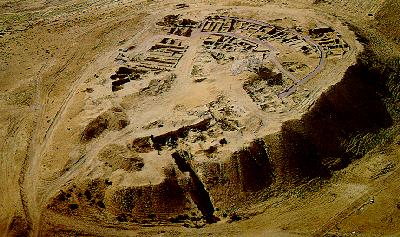|
Visit our website to hear this program free! |
|
|

|
Subscribe to podcast. |
|
"Out of Tsiyon,
the perfection of beauty,
God shines forth"
Psalm 50:2 |
Tsiyon News |
|
 |
 May's EBD Crossword Contest
May's EBD Crossword Contest
There's
still time!
You
can find this latest crossword puzzle on my website blog at
eliyahubendavid.com. Do it for fun or do it to win a prize.
TSIYON PARTNER
MEETING
Partners - Are you having trouble accessing the latest Tsiyon
Partner Meeting recording? Please write to us at
help[at]tsiyon.org or call 888-230-2440 (US & Canada) or
469-619-0876 for assistance.
Beersheba - Southern
Border
of the Kingdom of Judah
Source: Israel Ministry of
Foreign Affairs - mfa.gov.il

Tel Sheva, the mound
of biblical Beersheba, is located in the northern Negev, several
kilometers east of the present-day city of Be'er Sheva. The Arabic
name of the mound, Tell es-Sab'a, preserves the biblical name; the
archeological finds support its identification with biblical
Beersheba.
The ancient town was built on a low hill on the bank of a wadi (dry
river-bed), which carries floodwater during the winter months. A
close-to-the-surface aquifer along the wadi ensured the year-round
supply of water.
Beersheba is first mentioned in the biblical account of God's
revelation to the patriarchs (Gen. 26:23-25; 46:1) and its name is
derived from the Hebrew word shevu'a (oath) or shiv'a (seven) as
elaborated in Gen. 21:31 and 26:33. Beersheba symbolized the
southern boundary of the Land of Israel, as in the phrase from Dan
to Beersheba. (Judges 20:1; 1 Samuel 3:20; and 1 Kings 5:5)
A large area of the site was excavated between 1969 and 1976,
producing several layers of the remains of settlement, including
fortified towns of the early Israelite period and the monarchic
period of Judah, covered by remnants of small fortresses dated from
the Persian to the Roman periods.
The earliest remains of settlement at Beersheba are a number of
rock-hewn dwellings (12th-11th centuries BCE) and a 20 m.-deep well
supplying fresh water to the inhabitants of the first permanent
unfortified settlement of Israelites of the Tribe of Simon. (Joshua
19:2)
By the end of the 11th century BCE, a fortified settlement was
established at Beersheba with the houses built close to one another
on the hill's summit, forming an outer, circular defensive wall with
only a narrow opening for a gate. The houses opened inwards, towards
a central square, where livestock was kept.
In the mid-10th century BCE, during the monarchic period, the first
large fortified city was established at Beersheba, to serve as the
administrative center of the southern region of the kingdom. Its
area extended over some 10 dunams (2.8 acres) of the hill's summit.
It was a planned city, fortified by a solid wall of mudbrick on
stone foundations. The city gate, with a four-chambered gatehouse,
is typical of Israelite military architecture of that period. The
plan of this city, on broad lines, was preserved throughout the next
300 years, during which time it was rebuilt several times.
In the 9th century BCE, a new city wall was erected on the remains
of the previous one. The new casemate wall was composed of two
parallel walls with a narrow space between them which was divided
into small rooms, creating living and storage spaces within the
wall.
The uppermost layer of the mound revealed the 8th century BCE city
of Beersheba, a remarkable example of provincial town planning and
indicative of the importance of the city for the defense of the
southern border of the Kingdom of Judah at the end of the monarchic
period. The area of the walled city was divided into quarters;
peripheral, circular streets followed the course of the city wall
and a main street cut through the center of the town; and all the
streets met at the square inside its gate. A planned drainage system
was constructed beneath the streets to collect rainwater into a
central channel, which carried it under the city gate and outside
into the well. An impressive water system was also constructed in
the northeast of the city, within the wall, with a stone staircase
leading down to a water chamber cut deep into the rock. This
sophisticated system assured a regular water supply even in times of
long siege.


 May's EBD Crossword Contest
May's EBD Crossword Contest





 A large horned altar was uncovered at the site. It was reconstructed
with several well-dressed stones found in secondary use in the walls
of a later building. This altar attests to the existence of a temple
or cult center in the city which was probably dismantled during the
reforms of King Hezekiah. (1 Kings 18:4)
A large horned altar was uncovered at the site. It was reconstructed
with several well-dressed stones found in secondary use in the walls
of a later building. This altar attests to the existence of a temple
or cult center in the city which was probably dismantled during the
reforms of King Hezekiah. (1 Kings 18:4)